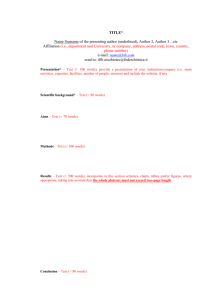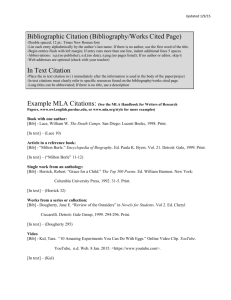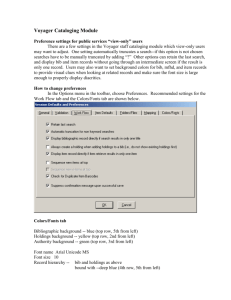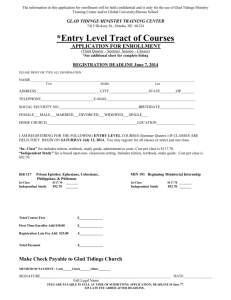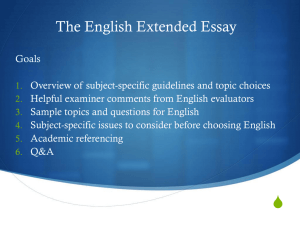8 Cowan Edited
advertisement
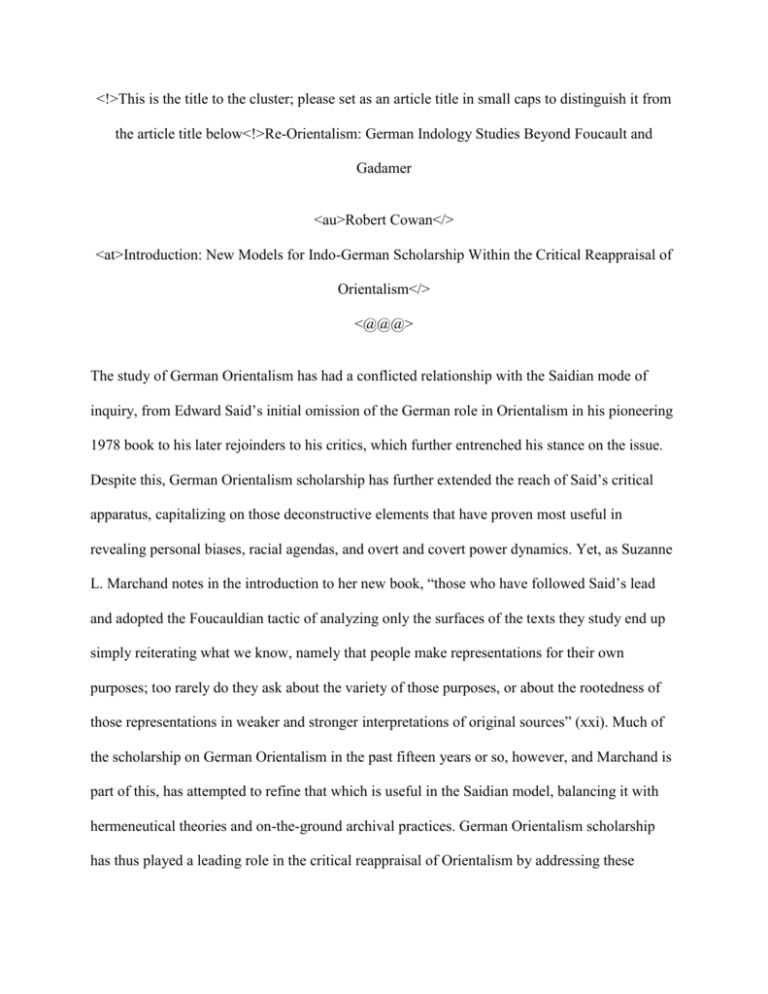
<!>This is the title to the cluster; please set as an article title in small caps to distinguish it from the article title below<!>Re-Orientalism: German Indology Studies Beyond Foucault and Gadamer <au>Robert Cowan</> <at>Introduction: New Models for Indo-German Scholarship Within the Critical Reappraisal of Orientalism</> <@@@> The study of German Orientalism has had a conflicted relationship with the Saidian mode of inquiry, from Edward Said’s initial omission of the German role in Orientalism in his pioneering 1978 book to his later rejoinders to his critics, which further entrenched his stance on the issue. Despite this, German Orientalism scholarship has further extended the reach of Said’s critical apparatus, capitalizing on those deconstructive elements that have proven most useful in revealing personal biases, racial agendas, and overt and covert power dynamics. Yet, as Suzanne L. Marchand notes in the introduction to her new book, “those who have followed Said’s lead and adopted the Foucauldian tactic of analyzing only the surfaces of the texts they study end up simply reiterating what we know, namely that people make representations for their own purposes; too rarely do they ask about the variety of those purposes, or about the rootedness of those representations in weaker and stronger interpretations of original sources” (xxi). Much of the scholarship on German Orientalism in the past fifteen years or so, however, and Marchand is part of this, has attempted to refine that which is useful in the Saidian model, balancing it with hermeneutical theories and on-the-ground archival practices. German Orientalism scholarship has thus played a leading role in the critical reappraisal of Orientalism by addressing these aporiae in Said’s work and critically reflecting on his model’s efficacy, prejudices, and goals. Within these endeavors, the study of German Indology has proven particularly fruitful, for closer examination reveals that the intellectual relationships between Germany and South Asia provide instances of “colonial” contact that differ in some dramatic ways from the Anglo-French contexts that Said and others have emphasized, for Germans had very different agendas. Indeed, I would argue that the intellectual relationships between Germany and South Asia have had ramifications for Western thought that are more profound than any other Orientalist discourse. In 2007, I organized a panel for the Modern Language Association convention in Chicago entitled “The Indo-Germans: The German Misappropriation of Indian Philosophy,” featuring Gabrielle Bersier, Sai Bhatawadekar, and Thomas Paul Bonfiglio. The German Studies Association president Sara Lennox then asked me to organize a follow-up panel for the Association’s 2008 conference in St. Paul, which I did, entitled “Re-Orientalism: Beyond Foucauldian Paradigms.” That panel featured Nicholas A. Germana, Bradley L. Herling, Douglas T. McGetchin, and myself, with Bhatawadekar as moderator and Peter K. J. Park as respondent. I felt that Herling’s, Germana’s, and McGetchin’s papers went very well together: Herling presented a challenge to the critical context in which this scholarship is taking place, and Germana and McGetchin served as excellent examples of refinements of existing models that are being taken in new directions. These three scholars are part of an important new wave of scholarship on German Indology, each with recent monographs, contributions to anthologies, and journal articlesi—the articles in this cluster for The Comparatist grew out of those presentations at the 2008 GSA. The fact that I am a comparatist, Herling a religion scholar, and Germana and McGetchin scholars of intellectual and cultural history, and that we all work on German Orientalism is indicative of the topic’s polyvalent nature. German Orientalism is an area of inquiry has both expanded its scope and refined its modes of investigation rather dramatically in the past sixty years, and not only in response to Said. That this branch of Orientalist study finally should garner such tremendous attention is only logical, for it is an incredibly rich area for scholars in a variety of disciplines. Such comparative analyses are vital to the growth of German Studies as it seeks to hold its place institutionally, for while the study of German may be in severe decline as opposed to languages such as Chinese or Spanish, the role of German thinkers in the history of both European and global thought remains central. <h1>A Brief History of German Orientalism Scholarship</> Orientalism in Germany drew on two separate sources: the relationship between the Ottoman and Holy Roman (later Habsburg) Empires, on the one hand, and the “Oriental Renaissance” spurred by the translation of Sanskrit texts into European languages, on the other. As there are, thus, a large constellation of disciplines to be involved here (history, literature, linguistics, political science, anthropology, art history, etc.), scholarship on German Orientalism has tended to fall into several overlapping categories. As so much of this work has been interdisciplinary, these categories could be divided up in a number of ways. The following is a general by not necessarily exhaustive list, and in no particular order. German Orientalism scholarship concerns: <ext>European travel-writing about the Middle East, South Asia, and East Asia, as well as depictions of such journeys in the visual arts Biographies of specific Orientalists Attempts to foster “cross-cultural understanding” Theoretical discussions of Orientalism, colonialism, and postcolonialism The role of Asian religions in European philosophy The Indo-Aryan “Myth” and the anthropology of race The ideological roots of German Nationalism and National Socialism Language, Philology, Translation, and the Institutionalization of Orientalism in German Universities Indian intellectuals’ views of German work</ext> The foundational scholarly text for the study of German Indology, Raymond Schwab’s La renaissance orientale, was published in 1950 and between 1950 and 1981 the most prominent contributions to this literature include A. Leslie Willson (1964), Ernst Behler (1968), Léon Poliakov (1971), and Wilhelm Halbfass (1981). We might gloss the trajectory of this work as citing the dramatic philosophical and anthropological importance of the “Oriental Renaissance” for European intellectual history, to explaining the ways in which European scholars mythologized Asia, to vilifying the abuse of such mythology for racist ends, to a more sober and comprehensive attempt to understand the utility of Indo-German cultural relations. Despite these foundational texts in the field, the German case had received much less attention than its English or French counterparts until rather recently. It was really not until the 1990s that the study of German Orientalism hit its stride, with the work of Dorothy M. Figueira, Ronald Inden, Partha Mitter, Kamakshi Murti, Sheldon Pollock, and Susanne Zantop, to name only a few major contributors to what has become a growing field of inquiry. Much of this groundbreaking work, particularly in regard to German Indology, has been a response to the notion that Germany, which, unlike England and France, came to colonialism late and on a smaller scale, did not share with its European neighbors the same kind of exoticizing power dynamics. In Orientalism (1978), Said does not acknowledge the enormous project of German national self-determination with which German Indology was intertwined, for the Germans were the groundbreaking Sanskrit scholars of the nineteenth century, during a period in which they also struggled to define themselves in relation to both Latinate and Christian culture and as a modern nation. Figueira faults Said for consigning the Orientalist himself to a position that is <ext>merely a function of political forces rather than an expression of the private motives and desires that inspire the individual artist or scholar. Said’s argument disregards the testimony of a text’s language, reception, and character as narrative, poetry, translation, or scholarship. By linking texts with certain cultural practices, Said imposes a systematized coherence on the historical past that presupposes the political experience of the twentieth century. (56)</ext> Indeed, this criticism is particularly relevant to the study of late eighteenth- and nineteenthcentury German proponents of Indian wisdom, such as J. G. Herder and Friedrich Schlegel, for they brought to the study of Sanskrit texts their own search to establish a set of German national origins that were independent of the Greco-Roman and Judeo-Christian traditions. They also strove to postulate how modern Germany might regenerate an enervated Europe and bring about what they felt to be its enlightened (Lutheran or Catholic) destiny. What Figueira emphasizes throughout her critique of Said is the personal nature of such Orientalists’ engagement with India and, in his pioneering 1993 article, “Deep Orientalism?: Notes on Sanskrit and Power beyond the Raj,” Sanskritist Sheldon Pollock makes a similar critique. Pollock argues that German intellectuals were engaged in forms of “internal colonialism”ii which employed ideas from and about India, Sanskrit, and Hinduism for their own national interests (82). “The case of German Indology, a dominant form of European orientalism, leads us to ask whether orientalism cannot be powerfully understood with reference to the national political culture within which it is practiced as to the colony toward which it is directed” (76). Thus, since the early 1990s, scholars such as Figueira and Pollock have sought to situate the peculiar case of German Orientalism, and particularly German Indology, within a framework that emphasizes the participants’ personal struggles to self-define. These are struggles to reconcile Eastern and Western explanations of the universe and Europeans’ role in it as a means of understanding their own geographical, linguistic, and spiritual origins, as well as their purpose and destiny. The early twenty-first century has continued what has become an explosion of exciting new work (monographs, essay anthologies, and articles) on these categories of German Orientalist scholarship cited above. At the risk of essentializing them myself (and I’m sure many readers will have scholars to add to this list), some prominent recent contributions to the literature might be classified as such: <ext>Todd Kontje has applied a more refined version of the Saidian model to the study of German literary history Scholars such as Kamakshi P. Murti, Vasnat Kaiwar, Sucheta Muzumdar, and Sumit Sarkar have addressed the intersections of race, gender, and nation, in German Orientalism and modern India’s relationship to it Suzanne Marchand, Douglas McGetchin, and Indra Sengupta have concentrated on institutionalized academic Orientalism Related to that work, Tuska Benes, Bradley Herling, and Pascale RobaultFeuerhahn have directed our attention to debates about hermeneutics, linguistics, and philology within such institutionalization Nicholas Germana, Peter K. J. Park, Chen Tzoref-Ashkenazi, George S. Williamson, and I have focused on the relationships between religion, aesthetics, and nationalism in German Indology Thomas R Trautmann, Edwin Bryant, and Stefan Arvidsson have engaged new debates about the mythology of “the Aryans” and Aryanism And scholars like Robert Irwin and Kris Manjapra have revisited the careers of specific Orientalists and explored India intellectuals’ relations with Germany.</ext> As part of this recent wave of scholarship, the intention of this cluster of articles is to take Figueira’s and Pollock’s critiques further and argue that, in the German case, Orientalism can only be understood as a set of personal attempts to appropriate foreign concepts, motifs, and stories in an effort to tell Germany’s own unique story. This cluster also seeks, though, to question the critical and hermeneutical methods by which such understanding comes about. <h1>This Cluster’s Contribution to the Field</> The contribution of Bradley L. Herling in “‘Either a Hermeneutical Consciousness of a Critical Consciousness’: Renegotiating Theories of the Germany-India Encounter” lies in his taking stock of what the frameworks have been for theoretical debate historically and currently and presenting a challenge to develop new models. Herling employs a distinction made by Paul Ricoeur between “hermeneutical” and “critical” consciousnesses (identified with Hans-Georg Gadamer and Jürgen Habermas, respectively) in his look at German India scholarship at the turn of the nineteenth century and since, in the hope of understanding the paths it has forged. Then, Herling attempts to “chart some new theory-driven pathways through the historical thicket of the Germany/India encounter.” In evoking one of the masterworks of the field, Wilhelm Halbfass’s India and Europe, Herling notes that Halbfass (who, most would agree with Herling, came down on the side of hermeneutics) specifically emphasized that “gaining better knowledge about India in Germany depended entirely on India becoming a genuine challenge to the self-understanding of German intellectuals; they were prompted to become Other to themselves.” Herling then turns to recent scholars such as Ronald Inden and Kamakshi Murti, who have emphasized the European feminization of Indian thought and the dramatic ramifications of its concomitant racial hierarchizations, as examples of the “critical consciousness” in action. In the central portion of his essay, Herling traces the “hermeneutical consciousness” in the early German interpretation of the Bhagavadgītā from Herder (via Friedrich Schlegel, Franz Bopp, and August Wilhelm Schlegel) to Wilhelm von Humboldt, emphasizing the eventual tempering of initial and developed Gadamerian “prejudices.” He then, however, points out how Humboldt’s hermeneutical openness was appropriated by others and employed in the further reinforcement of power relationships. Thus, Herling asks, “How should this history be done, and assuming that it can be done faithfully, what conclusions should we draw from it?” He wonders whether recognition of the potential further enforcement of power imbalances texts that are hermeneutically careful and make real strides in cross-cultural understanding does not cancel out both schools of “consciousness.” In the hope of bridging this impasse, Herling then points out scholarly contributions that have attempted, à la Ricoeur, to synthesize the hermeneutic and the critical, works by A. Leslie Willson, Richard King, Dorothy Figueira, and Bruce Lincoln. He argues that, “we must be able to account for both intellectual progress and ideological retrenchment.” Herling proposes the “revivifying of the old vocabulary of ‘myth’ and ‘logos’ to distinguish and describe the prejudicial structures that we find in the work of intellectuals and their communities.” “Myth,” as “ideology in narrative form” corresponds to the “critical consciousness” and “logos” corresponds to the “application of technique and method to the project of cross-cultural understanding.” Herling also usefully emphasizes looking at how intellectual communities transform “pre-ideas” into concepts that often hang around long after they have exhausted their use, as well as the actual “event[s] of contact between European intellectuals and India.” Finally, Herling advocates for close reading of the ways in which textual practices were undertaken, from the native teachers of the foreign languages to local debates on such issues as canonicity to the ways in which translations of foreign texts were presented to the public. *<!>Please use an ornament rather than the asterisk<!> Nicholas A. Germana’s work on German Orientalism has brought together the strains of argument pertaining to the development of German political self-determination and the institutionalization of its Orientalism. His “Self-Othering in German Orientalism: The Case of Friedrich Schlegel” addresses the well-known lacuna in Said’s account of Orientalism by extending and elaborating on the “internal colonialism” argument made by scholars like Sheldon Pollock. Germana argues that Germany employed imagery of the Orient in the late eighteenth and early nineteenth centuries, not to identify itself with European colonial powers such as England and France, but to identify itself with Asia, in a process of “self-Othering.” Germana contextualizes the unusual relationship between German self-Othering and the Sonderweg thesis in German history by drawing parallels to Irish Orientalism and to British feminism, as well as by pointing out some of its precedents in idealized descriptions of the inhabitants of the New World by Montaigne and Las Casas. Germana finds that, for German intellectuals, self-Othering is “a curious rhetorical strategy which involves two distinct forms or acts of Othering—the imaginative construction of the oriental Other with whom to identify, and of the western imperial Other, against whom one is seeking to construct an identity.” This “provide[s] the starkest possible contrast between oriental Germany and the corrupting, even barbarous West.” Germana then addresses two scholars “whose arguments are noteworthy for taking the examination of German Orientalism in a slightly different and intriguing direction by drawing attention to the identification of many German thinkers with the victims of French and British imperialism”: Susanne Zantop and Todd Kontje. He notes that “Zantop acutely concluded that ‘as German states are overrun by French revolutionary armies, (some) Germans discover their kinship with other ‘enslaved’ or ‘colonized’ peoples.’” While Kontje resolves that, “‘the very lack of a unified nation-state and the absence of empire contributed to the development of a peculiarly German Orientalism. German writers oscillated between identifying their country with the rest of Europe against the Orient and allying themselves with selected parts of the East against the West’ (2–3).” Thus, Germana further emphasizes, alongside Liah Greenfield, the ambivalent relationship of Germany to Western Europe, based on anxiety about cultural competition. Germana then moves on to Friedrich Schlegel, as an example that refutes Said’s contention that Europe was always held up by Orientalists as the Orient’s “contrasting image, idea, personality, experience.” He traces Schlegel’s early Orientalist career, his criticisms of Latinate (i.e., French) culture, and the identification of German culture with that of Vedic South Asia, paying particular attention to how they play out in his Über die Sprache und Weisheit der Indier (1808). He laments, however, and perhaps will provoke some other scholar, that, “the shift from his early, vague, romantic Orientalism to his more earnest investigation into ancient Indian language and thought has been left unexplored” thus far. *<Please use an ornament rather than an asterisk<!> Finally, in “Indo-German Connections, Hermeneutical and Critical, in the First World War,” Douglas T. McGetchin finds the two poles in German Orientalism that Herling discusses in his essay, glossed by McGetchin as “a Saidian focus on power differentials and exploitation versus a Gadamerian emphasis on shared dialogue,” in the First World War. McGetchin notes in the German support of revolutionary movements in countries such as India a conflict between the impulse to support social underdogs who sought to free themselves from despotic, often colonial, governments, and the impulse to attempt to build their own German empire on the English model. The Indo-German connections during the First World War, he goes on, defy merely hermeneutical or critical interpretation, for the German attempt to undermine British power among South Asians and the Indian independence movement abroad comprised only the latest episode in a relationship of mutual interest and admiration that deeply intertwined philological investigation, textual exegesis, philosophical speculation, and political pragmatism. In the first half of his essay, McGetchin traces the complexities of these contradictory relationships, emphasizing the role of South Asian revolutionary expatriates and their trepidacious relations with German powers, through the example of Virendranath “Chatto” Chattopadhyaya’s Berlin India Committee and Baron von Oppenheim’s Muslim plan. He notes, “unlike the European-Middle Easterner adversarial dynamic Edward Said documents, both Indians and Germans were fixated on the anti-colonial struggle of prying British control away from the Indian subcontinent. Thus, the German interest in helping Indian independence was linked directly to a mutual enemy, the British.” Yet, he adds that, “Germans disparaged Indians as ‘coloured Englishmen,’” and that they criticized (then copied) the “savage” tactics of India troops fighting for the British on the Western Front. McGetchin then connects the initial Indomania of the early German Romantics to the polyvalent early-twentieth-century German view of South Asia. “The tensions within German attitudes towards India have to do with the differences between the ‘official Germans’ of diplomatic and military circles and that of Germans who were influenced by the strain of India culture intensely studied by German scholars.” He quotes Nirode K. Barooah, who points out that, “educated Indians never got any sympathy for their political aspirations from the official Germans throughout the pre-War period... The German diplomats in India being down-to-earth practical men of business had nothing to do with ancient Indian history and culture. One does not find in their reports a mention of Indology and its impact in Germany ... [and] many ... found some of the Hindu customs simply revolting.” And McGetchin uses figures such as the Indologist Helmuth von Glasenapp as examples of those unique characters that embodied both of these attitudes. On the whole, however, during the period of the First World War, “official critical interaction trumped cultural hermeneutics,” for “the Germans’ hearts were more with the British as fellow Europeans than with the Indians.” The Weimar Republic would see a wider, more liberal view of South Asian culture. Yet, the ambivalent relationship is charted in postwar Indian literature that reflects on the period. In this second half of the essay, McGetchin turns to literature and focuses on Mulk Raj Anand’s Across the Black Waters (1940) and W. Somerset Maugham’s Ashenden (1941) as examples of this hermeneutical-critical tension. Anand’s novel largely centers on the respect and curiosity shown each for the other between Indian sepoys and German soldiers, and “represents the fruition of the anti-British ‘agitation’ that Chatto and his Berlin Committee sought to propagate.” Maugham’s Ashenden presents the wish fulfillment of the British capture of a fictionalized Chatto. In the end, McGetchin decides that, “perhaps the greatest legacy Indo-German cooperation during the First World War had was on the Indian independence movement.” McGetchin recognizes and employs the wider definition of the term “hermeneutic,” emphasizing not so much its exegetical utility as its larger significance in cross-cultural understanding. <h1>Conclusion</> McGetchin is one of the few people exploring the early twentieth-century developments in German Indomania who is not exclusively preoccupied with Nietzsche or with trying to explain the ideological origins of the Third Reich. His nuanced approach to the constellation of relationships between Germans, Indians, and Englishmen shows how complex these relationships were, governed by ever-shifting political agendas as well as by elective affinities. Similarly, Germana turns the idea of subalternaity inside out, highlighting the ways in which figures such as Schlegel identify by turns with Europe and with South Asia depending on the philosophical or political issue under review. Such methods of investigation answer Herling’s call for models that balance the critical and the hermeneutical, for, without being purely psychological, they privilege the inconsistency of personal affiliations. The future of these studies, at least immediately, will lie in pulling back from the personal and balancing it with more macrocosmic preoccupations, associations, and prejudices, in an effort to understand how the personal becomes the global and vice versa. The “Oriental Renaissance” began on the eve of Romanticism, would be transformed by empirical and biological concerns in the periods of Realism and Naturalism, and would revivify and further mutate its Romantic beginning through the Modernist period. It would oscillate between great ogygian myths, hopeful philosophical similarities, supposedly irrefutable scientific proofs, and arguments for enlightened European destinies. Similarly, scholarship on German Orientalism has oscillated between exposés of racism, the damning or deepening or supposed philosophical parallels, the further use of empirical science to prove or disprove theories of origin, and arguments for how the lessons gleaned from such investigations might lead to the enlightened destiny of all people. But, just as the German Orientalist writing that is most useful engages Indian thought and culture on its own terms in an attempt to respectfully understand it, so must scholarship in this field attempt to understand the milieus in which such texts were written, in all their various facets: political, philosophical, aesthetic, religious, institutional, the personal, and the global. <#><aff>Kingsborough Community College of the City University of New York</> <bmh>Works Cited</> <bib>Figueira, Dorothy M. The Exotic: A Decadent Quest. Albany: State University of New York Press, 1994. </bib> <bib>Jenkins, Jennifer. “German Orientalism: Introduction,” Comparative Studies of South Asia, Africa, and the Middle East 24.2 (2004): 97–100. </bib> <bib>Marchand, Suzanne L. German Orientalism in the Age of Empire: Religion, Race, and Scholarship. German Historical Institute. Cambridge: Cambridge University Press, 2009. </bib> <bib>Pollock, Sheldon. “Deep Orientalism?: Notes on Sanskrit and Power Beyond the Raj.” Orientalism and the Postcolonial Predicament: Perspectives on South Asia. Philadelphia: University of Pennsylvania Press, 1993. 76–133. </bib> <bmh>Select Bibliography of Scholarship on German Indology, 1950–2010</> <bib>Allen, Charles. The Search for the Buddha: The Men Who Discovered India’s Lost Religion. New York: Carroll and Graf, 2002. </bib> Aronson, Alex. Europe Looks at India: A Study in Cultural Relations. Calcutta: Riddhi-India, 1979. </bib> <bib>Arvidsson, Stefan. Aryan Idols: Indo-European Mythology as Ideology and Science. Trans. Sonia Wichmann. Chicago: University of Chicago Press, 2006. </bib> <bib>Behler, Ernst. “Das Indienbild der deutschen Romantik.” Germanisch-Romanische Monatsschrift 1 (1968): 21–37. </bib> <bib>Benes, Tuska. In Babel’s Shadow: Language, Philology, and the Nation in NineteenthCentury Germany. Detroit: Wayne State University Press, 2008. </bib> <bib>Berman, Antoine. L’épreuve de l’étranger: culture et traduction dans l’Allemagne romantique: Herder, Goethe, Schlegel, Novalis, Humboldt, Schleiermacher, Hölderlin. Paris: Gallimard, 1984. </bib> <bib>Berman, Russell A. Enlightenment or Empire: Colonial Discourse in German Culture. Lincoln: University of Nebraska Press, 1998. </bib> <bib>Bernal, Martin. Black Athena: The Afroasiatic Roots of Classical Civilization. Volume I: The Fabrication of Ancient Greece, 1785–1985. Newark: Rutgers University Press, 1987. </bib> <bib>Bhatawadekar, Sai. “Rewriting Indian Thought: Hegel’s and Schopenhauer’s Interpretations of Indian Philosophy and Religion.” “Mapping Channels between Ganges and Rhine: German-Indian Cross-Cultural Relations.” Interdisciplinary conference. University of Toronto, 25–26 May 2006. </bib> <bib>_____. “Three-fold Conceptual Structure of Hegel and Schopenhauer’s Interpretation of Hindu Religious Philosophy.” “Theory, Faith, Culture: An International Interdisciplinary Conference.” Cardiff University. 4–6 July 2007. </bib> <bib>Bhatti, Anil, and Horst Turk, eds. Kulturelle Identität. Deutsch-indische Kulturkontakte in Literatur, Religion und Politik. Berlin: Erich Schmidt Verlag, 1997. </bib> <bib>______. Reisen, Entdeckungen, Utopien. Jahrbuch für Internationale Germanistik, Reihe A, Kongressberichte, Bd. 48. Bern: Peter Lang, 1998. </bib> <bib>Bonfiglio, Thomas Paul. “Toward a Genealogy of Aryan Morality: Nietzsche and Jacolliot.” New Nietzsche Studies. 6.1–2 and 7.1–2 (Fall 2005 and Spring 2006): 170–84. </bib> <bib>Breckenridge, Carol A. and Peter van der Veer. Orientalism and the Postcolonial Predicament: Perspectives on South Asia. Philadelphia: University of Pennsylvania Press, 1993. </bib> <bib>Bryant, Edwin. The Quest for the Origins of Vedic Culture: The Indo-Aryan Migration Debate. New York: Oxford University Press, 2001. </bib> <bib>Bryant, Edwin F. and Laurie L. Patton, eds. The Indo-Aryan Controversy: Evidence and Inference in Indian History. New York: Routledge, 2005. </bib> <bib>Cannon, Garland and Kevin Brine, eds. Objects of Enquiry: Life, Contributions and Influence of Sir William Jones (1746–1794). New York: New York University Press, 1995. </bib> <bib>Chaudhuri, Nirad. Scholar Extraordinary: The Life of Professor the Rt. Hon. Friedrich Max Muller. London: Chatto and Windus, 1974. </bib> <bib>Childe, V. Gordon. The Aryans: A Study of Indo-European Origins. New York: Dorset, 1987. </bib> <bib>Clarke, J. J. Oriental Enlightenment: The Encounter Between Asian and Western Thought. London: Routledge, 1997. </bib> <bib>Cowan, Robert. “Fear of Infinity: Friedrich Schlegel’s Indictment of Indian Philosophy in Über die Sprache und die Weisheit der Indier.” The German Quarterly 81.3 (Summer 2008): 322–38. </bib> <bib>_____. The Indo-German Identification: Reconciling South Asian Origins and European Destinies, 1765–1885. Rochester: Camden House, 2010. </bib> <bib>_____. “Nietzsche’s Attempted Escape from Schopenhauer’s South Asian Sources in The Birth of Tragedy.” German Studies Review 30.3 (October 2007): 537–56. </bib> <bib>Dahlquist, Allan. Megasthenes and Indian Religion: A Study in Motives and Types. Delhi: Motilal Banarsidass, 1962. </bib> <bib>Dalrymple, William. “The Case for India.” The New York Review of Books 53,3 (2006): 29–30. </bib> <bib>_____. “India: The War Over History.” The New York Review of Books 52.6 (2005): 62– 65. </bib> <bib>Dann, Otto. Nation und Nationalismus in Deutschland, 1770–1990. München: C. H. Beck, 1994. </bib> <bib>Droit, Roger-Pol. Le culte du néant: les philosophes et le Bouddha. Paris: Éditions du Seuil, 1997. </bib> <bib>Erdosy, George, ed. The Indo-Aryans of Ancient South Asia: Language, Material Culture and Ethnicity. Berlin and New York: de Gruyter, 1995. </bib> <bib>Figueira, Dorothy Matilda. Aryans, Jews, Brahmins: Theorizing Authority through Myths of Identity. Albany: State University of New York Press, 2002. </bib> <bib>_____. The Exotic: A Decadent Quest. Albany: State University of New York Press, 1994. <bib>_____. Translating the Orient: The Reception of Sakuntala in Nineteenth-Century Europe. Albany: State University of New York Press, 1991. </bib> <bib>Friedrichsmeyer, Sara, Sara Lennox, and Susanne Zantop, eds. The Imperialist Imagination: German Colonialism and Its Legacy. Ann Arbor: University of Michigan Press, 1998. </bib> <bib>Gérard, Réne. L’Orient et la pensée romantique allemande. Paris: Marcel Didier, 1963. <bib>Germana, Nicholas A. “The Beauty of Enervation: Woman, India, and the Anxiety of System in Hegel’s Philosophy.” German Studies Review, forthcoming. </bib> <bib>_____. “German Diligence and German Profundity: The Institutionalization of Sanskrit Studies in Prussian Universities, 1818–1830.” Mapping Channels between Ganges and Rhein. Eds. Joerg Esleben, Christina Kraenzle, and Sukanya Kulkarni. Newcastle upon Tyne: Cambridge Scholars Publishing, 2008. 14–28. </bib> <bib>_____. “Herder’s India: The ‘Morgenland’ in Mythology and Anthropology.” Anthropology of the Enlightenment. Eds. Larry Wolff and Paul Cipolloni. Stanford: Stanford University Press, 2007. 119–37. </bib> <bib>_____. The Orient of Europe: The Mythical Image of India and Competing Images of German National Identity. Newcastle upon Tyne: Cambridge Scholars Publishing, 2009. </bib> <bib>Glasenapp, Helmut V. Das Indienbild deutscher Denker. Stüttgart: K. F. Koehler, 1960. </bib> Goodrich-Clarke, Nicholas. Hitler’s Priestess: Savitri Devi, the Hindu-Aryan Myth, and NeoNazism. New York: New York University Press, 1998. </bib> <bib>_____. The Occult Roots of Nazism: Secret Aryan Cults and Their Influence on Nazi Ideology: The Ariosophists of Austria and Germany, 1890–1935. New York: New York University Press, 1985. </bib> <bib>Halbfass, Wilhelm. India and Europe: An Essay in Understanding. Delhi: Motilal Banarsidass, 1990. </bib> <bib>_____. Indien und Europa: Perspektiven ihrer geistigen Begegnung. Basel: Schwabe, 1981. </bib> <bib>Hawley, Daniel S. “L’Inde de Voltaire.” Studies on Voltaire and the Eighteenth Century. Vol. 120. Ed. Theodore Besterman. Oxfordshire: Therpe Mandeville (1974) 139–78. </bib> <bib>Herling, Bradley L. “Epilinguistic Hypophecy: August Wilhelm Schlegel’s Latin Bhagavadgita.” Epilanguages: Beyond Idioms and Languages. Ed. Pascale Hummel. Paris: Philologicum, forthcoming, 2010. </bib> <bib>_____. “The Problem of Action in the Early German Interpretation of the Bhagavadgītā.” Mapping Channels between the Ganges and the Rhine. Eds. Joerg Esleben, Christina Kraenzle, and Sukanya Kulkarni. Newcastle upon Tyne: Cambridge Scholars Publishing, 2008. 82–106. </bib> <bib>_____. The German Gītā: Hermeneutics and Discipline in the German Reception of Indian Thought, 1778–1831. Studies in Philosophy Series, ed. Robert Bernasconi. New York: Routledge, 2006. </bib> <bib>Hulin, Michel. Hegel et l’Orient. Paris: J. Vrin, 1979. </bib> <bib>_____. “Nietzsche and the Suffering of the Indian Ascetic.” Nietzsche and Asian Thought. Ed. Graham Parkes. Chicago: University of Chicago Press, 1991. 64–75. </bib> <bib>Inden, Ronald. Imagining India. Cambridge: Oxford University Press, 1990. Irwin, Robert. For Lust of Knowing: The Orientalists and their Enemies. London: Allen Lane, 2006. </bib> <bib>Kaiwar, Vasnat and Sucheta Muzumdar, eds. Antinomies of Modernity: Essays on Race, Orient, Nation. Durham: Duke University Press, 2003. </bib> <bib>Keay, John. India Discovered: The Achievement of the British Raj. New York: Harper Collins, 1992. </bib> <bib>Kirfel, Willibald. “Shiva und Dionysos.” Zeitschrift für Ethnolgie 78 (1953): 83–90. </bib> <bib>Kontje, Todd. German Orientalisms. Ann Arbor: University Michigan Press, 2004. </bib> <bib>Lefkowitz, Mary R. and Guy MacLean Rogers, eds. Black Athena Revisited. Chapel Hill: University North Carolina Press, 1996. </bib> <bib>Leifer, Walter. Indien un die Deutschen: 500 Jahr Begegnung und Partnerschaft. Tübingen: Horst Erdmann Verlag, 1969. </bib> <bib>Lincoln, Bruce. Discourse and the Construction of Society. Oxford: Oxford University Press 1989. </bib> <bib>_____. Theorizing Myth: Narrative, Ideology, and Scholarship. Chicago: University of Chicago Press, 1999. </bib> <bib>Macfie, A. L. Orientalism: A Reader. New York: New York University Press, 2000. Maczynska, Magdalena. Die Völkerwanderung: Geschichte einer ruhelosen Epoche im 4. und 5. Jahrhundert. Zurich: Artemis & Winkler, 1993. </bib> <bib>Manjapra, Kris. M.N. Roy: Marxism and Colonial Cosmopolitanism, New Dehli: Routledge India, 2009. </bib> <bib>_____. “The Illusions of Encounter: Muslim ‘Minds’ and Hindu Revolutionaries in First World War Germany and After.” Journal of Global History 1.3 (November 2006): 363–82. <bib>Marchand, Suzanne L. Down from Olympus: Archaeology and Philhellenism in Germany, 1750–1970. Princeton: Princeton University Press, 1996. </bib> <bib>_____. German Orientalism in the Age of Empire: Race, Religion, and Scholarship. German Historical Institute. Cambridge: Cambridge University Press, 2009. </bib> <bib>McGetchin, Douglas T. Indology, Indomania, Orientalism: Ancient India’s Rebirth in Modern Germany. Madison: Fairleigh Dickinson University Press, 2009. </bib> <bib>_____. “‘Into the Centre of Sanskrit Study’: Ancient Indian Studies and German Culture in Berlin and Leipzig in the Nineteenth Century.” Sanskrit and “Orientalism”: Indology and Comparative Linguistics in Germany, 1750–1958. Eds. Douglas T. McGetchin, Peter K. J. Park, and Damodar SarDesai. New Delhi: Manohar, 2004. 197–29. </bib> <bib>_____, Peter K. J. Park, and Damodar SarDesai, eds. Sanskrit and “Orientalism”: Indology and Comparative Linguistics in Germany, 1750–1958. New Delhi: Manohar, 2004. </bib> <bib>_____. “Wayward Disciples: Indology and Buddhism in fin-de-siècle Germany.” Sanskrit and “Orientalism”: Indology and Comparative Linguistics in Germany, 1750–1958. Eds. Douglas T. McGetchin, Peter K. J. Park, and Damodar SarDesai. New Delhi: Manohar, 2004. 307–36. </bib> <bib>_____. “The Whitney-Müller Conflict and Indo-German Connections.” Mapping Channels Between Ganges and Rhein: German-Indian Cross-Cultural Relations. Eds. Jörg Esleben, Christina Kraenzle, and Sukanya Kulkarni. Newcastle upon Tyne: Cambridge Scholars Publishing, 2008. 29–50. </bib> <bib>_____. “Wilting Florists: The Turbulent Early Decades of the Société Asiatique, 1822– 1860.” Journal of the History of Ideas 64 (2004): 565–80. </bib> <bib>McKay, Alex. Tibet and the British Raj: The Frontier Cadre, 1904–1947. Surrey: Curzon, 1997. </bib> <bib>Mishra, Pankaj. “A Cautionary Tale for Americans.” The New York Review of Books 52.9 (26 May 2005): 8–11. </bib> <bib>Mistry, Freny. Nietzsche and Buddhism: Prolegomena to a Comparative Study. Berlin: De Gruyter, 1981. </bib> <bib>Mitter, Partha. Much Maligned Monsters: The History of European Reactions to Indian Art. Oxford: Clarendon, 1977. </bib> <bib>Morrison, Robert G. Nietzsche and Buddhism: A Study in Nihilism and Ironic Affinities. New York: Oxford University Press 1997. </bib> <bib>Murti, Kamakshi P. India: The Seductive and Seduced “Other” of German Orientalism. London: Greenwood, 2001. </bib> <bib>Myers, Perry. “Colonial Consciousness: Rudolf Steiner’s Orientalism and German Cultural Identity,” Journal of European Studies 36.4 (2006): 389–417. </bib> <bib>_____. “Monistic Visions and Colonial Consciousness: Ernst Haeckel’s Indische Reisebriefe,” Seminar 44.2 (2008): 190–209. </bib> <bib>Nicholls, Moira. “The Influences of Eastern Thought on Schopenhauer’s Doctrine of the Thing-in-Itself.” The Cambridge Companion to Schopenhauer. Ed. Christopher Janaway. Cambridge: Cambridge University Press, 1999. 171–212. </bib> <bib>Nussbaum, Martha C. “Nietzsche, Schopenhauer, and Dionysus.” The Cambridge Companion to Schopenhauer. Ed. Christopher Janaway. Cambridge: Cambridge University Press, 1999. 344–74. </bib> <bib>Olender, Maurice. The Languages of Paradise: Race, Religion, and Philology in the Nineteenth Century. Arthur Goldhammer, trans. Cambridge: Harvard University Press, 1992. </bib> <bib>Oppenberg, Ursula. Quellenstudien zu Friedrich Schlegels Übersetzungen aus dem Sanskrit. Marburg: N. G. Elwert, 1965. </bib> <bib>Orsucci, Andrea. “Ariani, indogermani, stirpi mediterranee: aspetti del dibattito sulle razze europee (1870–1914).” Cromohs 3 (1998): 1–9. </bib> <bib>Park, Peter K. J. “A Catholic Apologist in a Pantheistic World: New Approaches to Friedrich Schlegel.” Sanskrit and ‘Orientalism’: Indology and Comparative Linguistics in Germany, 1750–1958 Eds. Douglas T. McGetchin, Peter K. J. Park, and D.R. SarDesai. New Dehli: Manohar, 2004. 83–106. </bib> <bib>Poliakov, Léon. Le mythe aryen: essai sur les sources du racisme et des nationalismes. Paris: Calmann-Lévy, 1971. </bib> <bib>Pollock, Sheldon. “Deep Orientalism?: Notes on Sanskrit and Power Beyond the Raj.” Orientalism and the Postcolonial Predicament: Perspectives on South Asia. Eds. Carol A. Breckenridge and Peter van der Veer. Philadelphia: University of Pennsylvania Press, 1993. 76– 133. </bib> <bib>Prakash, Gyan “Orienalism Now.” History and Theory 34.3 (Oct. 1995): 199–212. Blackwell for Wesleyan U. http://www.jstor.org/stable/2505621. Accessed 09/05/2008 16:21. </bib> <bib>Preisendanz, Karin, ed. Expanding and Merging Horizons: Contributions to South Asian and Cross-Cultural Studies in Commemoration of Wilhelm Halbfass. Wien: Verlag der Österreichischen Akademie der Wissenschaften, 2007. </bib> <bib>Rajan, Gita and Radhika Mohanram, eds. Postcolonial Discourse and Changing Cultural Contexts. Westport: Greenwood Press, 1995. </bib> <bib>Rice, James P. “In the Wake of Orientalism.” Comparative Literature Studies 37.2 (2000): 223–38. </bib> <bib>Robault-Feuerhahn, Pascale. L’archive des origins: Sanskrit, philologie, anthropologie dans l’Allemagne du XIX siècle. Paris: Éditions du CERF, 2008. </bib> <bib>Römer, Ruth. Sprachwissenschaft und Rassenideologie in Deutschland. Munich: Wilhelm Fink Verlag, 1985. </bib> <bib>Rothermund, Dietman. The German Intellectual Quest for India. New Delhi: Publisher, 1986. </bib> <bib>Rubiés, Joan-Pau. Travel and Ethnology in the Renaissance: South India through European Eyes, 1250–1625. Cambridge: Cambridge University Press, 2000. </bib> <bib>Said, Edward W. Orientalism. New York: Random House, 1978. </bib> <bib>_____. The World, the Text, and the Critic. Cambridge: Harvard University Press, 1983. </bib> <bib>Sarkar, Sumit. Beyond Nationalist Frames: Postmodernism, Hindu Fundamentalism, History. Bloomington: Indiana University Press, 2002. </bib> <bib>Schwab, Raymond. La renaissance orientale. Paris: Payot, 1950. </bib> <bib>_____. The Oriental Renaissance: Europe’s rediscovery of India and the East, 1680–1880. Trans. Gene Patterson-Black and Victor Reinking. Foreword by Edward Said. New York: Columbia University Press, 1984. </bib> <bib>Sengupta, Indra. From Salon to Discipline: State, University and Indology in Germany, 1821–1914. Heidelberg: Ergon Verlag, 2005. </bib> <bib>Shapiro, Fred R. “On the Origin of the Term ‘Indo-Germanic’.” Historiographia Linguistica: International Journal for the History of Linguistics 8:1 (1981): 165–70. </bib> <bib>Smith, David. “Nietzsche’s Hinduism, Nietzsche’s India.” Journal of Nietzsche Studies 28 (Autumn 2004): 37–56. </bib> <bib>Spivak, Gayatri Chakravorty. A Critique of Postcolonial Reason: Toward a History of the Vanishing Present. Cambridge: Harvard University Press, 1999. </bib> <bib>_____. The Post-Colonial Critic: Interviews, Strategies, Dialogues. New York: Routledge, 1990. </bib> <bib>Stambaugh, Joan. Nietzsche’s Thought of the Eternal Return. Baltimore: Johns Hopkis University Press, 1972. </bib> <bib>Stemmrich-Köhler, Barbara. Zur Funktion der orientalischen Poesie bei Goethe, Herder, Hegel: Exotische Klassik und ästetische Systematik in den »Noten und Abhandlungen zu besserem Verständnis des West-östlichen Divans« Goethes, in Frührschriften Herder und in Hegels Vorlesungen zue Ästetik. Frankfurt am Main: Peter Lang, 1992. </bib> <bib>Teltscher, Kate. India Inscribed: European and British Writing on India, 1600–1800. New Delhi: Oxford University Press, 1995. </bib> <bib>Thapar, Romila. Early India: From the Origins to AD 1300. Berkeley: University of California Press, 2003. </bib> <bib>_____. History and Beyond. New Dehli, Oxford University Press, 2000. </bib> <bib>_____. Sakuntala: Texts, Readings, Histories. New Dehli: Kali for Women, 1999. </bib> <bib>_____, Jonathan Mark Kenoyer, Madhav M. Deshpande, and Shreen Ratnagar. India: Historical Beginnings and the Concept of the Aryan. New Dehli: National Book Trust, India, 2006. </bib> <bib>Trautmann, Thomas R. Aryans and British India. Berkeley: University of California Press, 1997. </bib> <bib>_____. The Aryan Debate. New Dehli: Oxford University Press, 2005. </bib> Tzoref-Ashkenazi, Chen. “India and the Identity of Europe: The Case of Friedrich Schlegel.” Journal of the History of Ideas 67.4 (Oct. 2006): 713–34. </bib> <bib>_____. “The Nationalist Aspect of Friedrich Schlegel’s On the Language and the Wisdom of the Indians.” Sanskrit and ‘Orientalism’: Indology and Comparative Linguistics in Germany, 1750–1958. Eds. Douglas T. McGetchin, Peter K. J. Park, and Damodar SarDesai. New Dehli: Manohar, 2004. 107–30. </bib> <bib>Williamson, George S. The Longing for Myth in Germany: Religion and Aesthetic Culture from Romanticism to Nietzsche. Chicago: University Chicago Press, 2004. </bib> <bib>Willson, A. Leslie. A Mythical Image: The Ideal of India in German Romanticism. Durham: Duke University Press, 1964. </bib> <bib>Zantop, Susanne. Colonial Fantasies: Conquest, Family, and Nation in Precolonial Germany, 1770–1870. Durham: Duke University Press, 1997. </bib> <bib>Ziolkowski, Theodore. German Romanticism and Its Institutions. Princeton: Princeton University Press, 1990.</bib> <bmh>Notes</> <en>i See the selected bibliography of scholarship on German Indology at the end of this introduction for each contributor’s publications in this field. ii Sheldon Pollock, “Deep Orientalism?: Notes on Sanskrit and Power Beyond the Raj” 82.</en>
